Joining of Ti6Al4V to Al2O3 Using Nanomultilayers
Abstract
:1. Introduction
2. Materials and Methods
2.1. Base Materials
2.2. Deposition of Ni/Ti Nanomultilayer Thin Films
2.3. Diffusion Bonding Process
2.4. Microstructural Characterization of the Nanomultilayers and Joints’ Interface
2.5. Mechanical Characterization
3. Results and Discussion
3.1. Ni/Ti Nanomultilayers Characterization
3.2. Diffusion Bonding Using Ni/Ti Nanomultilayers
4. Conclusions
Author Contributions
Funding
Data Availability Statement
Acknowledgments
Conflicts of Interest
References
- Mir, F.A.; Khan, N.Z.; Parvez, S. Recent advances and development in joining ceramics to metals. Mater. Today Proc. 2021, 46, 6570–6575. [Google Scholar] [CrossRef]
- Simões, S. Recent Progress in the Joining of Titanium Alloys to Ceramics. Metals 2018, 8, 876. [Google Scholar] [CrossRef] [Green Version]
- Cazajus, V.; Seguy, S.; Welemane, H.; Karama, M. Residual stresses in a ceramic-metal composite. Appl. Mech. Mater. 2012, 146, 185–196. [Google Scholar] [CrossRef] [Green Version]
- Leyens, C.; Peters, M. (Eds.) Titanium and Titanium Alloys; Wiley: Hoboken, NJ, USA, 2003; ISBN 9783527305346. [Google Scholar]
- Carter, C.B.; Norton, M.G. Ceramic Materials; Springer: New York, NY, USA, 2007; ISBN 978-0-387-46270-7. [Google Scholar]
- Zhang, Y.; Chen, Y.-K.; Yu, D.-S.; Sun, D.-Q.; Li, H.-M. A review paper on effect of the welding process of ceramics and metals. J. Mater. Res. Technol. 2020, 9, 16214–16236. [Google Scholar] [CrossRef]
- Uday, M.B.; Ahmad-Fauzi, M.N.; Noor, A.M.; Rajoo, S. Current Issues and Problems in the Joining of Ceramic to Metal. In Joining Technologies; Ishak, M., Ed.; InTech: Rijeka, Croatia, 2016; Chapter 8. [Google Scholar]
- Cai, X.Q.; Wang, D.P.; Wang, Y.; Yang, Z.W. Microstructural evolution and mechanical properties of TiB2-TiC-SiC ceramics joint brazed using Ti-Ni composite foils. J. Eur. Ceram. Soc. 2020, 40, 3380–3390. [Google Scholar] [CrossRef]
- Lu, Y.; Zhu, M.; Zhang, Q.; Hu, T.; Wang, J.; Zheng, K. Microstructure evolution and bonding strength of the Al2O3/Al2O3 interface brazed via Ni-Ti intermetallic phases. J. Eur. Ceram. Soc. 2020, 40, 1496–1504. [Google Scholar] [CrossRef]
- Li, C.; Zhang, K.; Mao, X.; Si, X.; Lan, B.; Liu, Z.-G.; Huang, Y.; Qi, J.; Feng, J.; Cao, J. Microstructure and mechanical properties of the AlON / Ti6Al4V active element brazing joint. Mater. Sci. Eng. A 2020, 793, 139859. [Google Scholar] [CrossRef]
- Emadinia, O.; Guedes, A.; Tavares, C.J.; Simões, S. Joining Alumina to Titanium Alloys Using Ag-Cu Sputter-Coated Ti Brazing Filler. Materials 2020, 13, 4802. [Google Scholar] [CrossRef]
- Cao, J.; Zheng, Z.J.; Wu, L.Z.; Qi, J.L.; Wang, Z.P.; Feng, J.C. Processing, microstructure and mechanical properties of vacuum-brazed Al2O3/Ti6Al4V joints. Mater. Sci. Eng. A 2012, 535, 62–67. [Google Scholar] [CrossRef]
- Akselsen, O.M. Diffusion bonding of ceramics. J. Mater. Sci. 1992, 27, 569–579. [Google Scholar] [CrossRef]
- Travessa, D.; Ferrante, M. The Al2O3-titanium adhesion in the view of the diffusion bonding process. J. Mater. Sci. 2002, 37, 4385–4390. [Google Scholar] [CrossRef]
- Liu, H.J.; Feng, J.C.; Nogi, K. Growth kinetics of reaction layers formed during diffusion bonding of SiC ceramic to TiAl alloy. Mater. Sci. Technol. 2004, 20, 1069–1072. [Google Scholar] [CrossRef]
- Liao, K.-H.; Su, C.-Y.; Yu, M.-Y. Interfacial microstructure and mechanical properties of diffusion-bonded W–10Cu composite/AlN ceramic using Ni–P and Ti interlayers. J. Alloys Compd. 2021, 867, 159050. [Google Scholar] [CrossRef]
- Liu, J.; Cao, J.; Song, X.; Wang, Y.; Feng, J. Evaluation on diffusion bonded joints of TiAl alloy to Ti3SiC2 ceramic with and without Ni interlayer: Interfacial microstructure and mechanical properties. Mater. Des. 2014, 57, 592–597. [Google Scholar] [CrossRef]
- Barrena, M.I.; Matesanz, L.; de Salazar, J.M.G. Al2O3/Ti6Al4V diffusion bonding joints using Ag-Cu interlayer. Mater. Charact. 2009, 60, 1263–1267. [Google Scholar] [CrossRef]
- Halbig, M.C.; Asthana, R.; Singh, M. Diffusion bonding of SiC fiber-bonded ceramics using Ti/Mo and Ti/Cu interlayers. Ceram. Int. 2015, 41, 2140–2149. [Google Scholar] [CrossRef]
- Yi, J.L.; Zhang, Y.P.; Wang, X.X.; Dong, C.; Hu, H. Characterization of Al/Ti Nano Multilayer as a Jointing Material at the Interface between Cu and Al2O3. Mater. Trans. 2016, 57, 1494–1497. [Google Scholar] [CrossRef] [Green Version]
- Xue, H.; Wei, X.; Guo, W.; Zhang, X. Bonding mechanism study of active Ti element and α-Al2O3 by using first-principle calculation. J. Alloys Compd. 2020, 820, 153070. [Google Scholar] [CrossRef]
- Wang, G.; Sun, X.N.; Xu, J.H.; Shan, Y.; Han, X.; Xu, J.; Li, J. Pressureless thermal diffusion bonding of transparent AlON ceramics by using a powder interlayer of parent material. Scr. Mater. 2019, 171, 118–121. [Google Scholar] [CrossRef]
- Silva, M.; Ramos, A.S.; Vieira, M.T.; Simões, S. Diffusion Bonding of Ti6Al4V to Al2O3 Using Ni/Ti Reactive Multilayers. Metals 2021, 11, 655. [Google Scholar] [CrossRef]
- Silva, M.; Ramos, A.S.; Simões, S. Joining Ti6Al4V to alumina by diffusion bonding using titanium interlayers. Metals 2021, 11, 1728. [Google Scholar] [CrossRef]
- Duarte, L.I.; Ramos, A.S.; Vieira, M.F.; Viana, F.; Vieira, M.T.; Koçak, M. Solid-state diffusion bonding of gamma-TiAl alloys using Ti/Al thin films as interlayer. Intermetallics 2006, 14, 1151–1156. [Google Scholar] [CrossRef] [Green Version]
- Simões, S.; Viana, F.; Ramos, A.; Vieira, M.T.; Vieira, M.F. Microstructural Characterization of Dissimilar Titanium Alloys Joints Using Ni/Al Nanolayers. Metals 2018, 8, 715. [Google Scholar] [CrossRef] [Green Version]
- Simões, S.; Viana, F.; Ramos, A.S.; Vieira, M.T.; Vieira, M.F. Reaction zone formed during diffusion bonding of TiNi to Ti6Al4V using Ni/Ti nanolayers. J. Mater. Sci 2013, 48, 7718–7727. [Google Scholar] [CrossRef]
- Ma, Y.; Li, H.; Yang, L.; Hu, A. Microstructures and reaction properties of Ti/Ni, Ti/Al and Ni/Al multilayer films. J. Nano Res. 2018, 54, 22–34. [Google Scholar] [CrossRef]
- Zhu, S.; Włosiński, W. Joining of AlN ceramic to metals using sputtered Al or Ti film. J. Mater. Process. Technol. 2001, 109, 277–282. [Google Scholar] [CrossRef]
- Cao, J.; Song, X.G.; Wu, L.Z.; Qi, J.J.; Feng, J.C. Characterization of Al/Ni multilayers and their application in diffusion bonding of TiAl to TiC cermet. Thin Solid Films 2012, 520, 3528–3531. [Google Scholar] [CrossRef]
- Adams, D.P.; Rodriguez, M.A.; McDonald, J.P.; Bai, M.M.; Jones, E., Jr.; Brewer, L.; Moore, J.J. Reactive Ni/Ti nanolaminates. J. Appl. Phys. 2009, 106, 093505. [Google Scholar] [CrossRef]
- Ye, J.-M.; Lin, Y.-P.; Yang, Y.-T.; Chang, J.-T.; He, J.-L. Electrochromic properties of Ni(V)Ox films deposited via reactive magnetron sputtering with a 8V–92Ni alloy target. Thin Solid Films 2019, 519, 1578–1582. [Google Scholar] [CrossRef]
- Yamamoto, S.; Yokomine, T.; Sato, K.; Terai, T.; Fukuda, T.; Kakeshita, T. Ab Initio Prediction of Atomic Location of Third Elements in B2-Type TiNi. Mater. Trans. 2018, 59, 353–358. [Google Scholar] [CrossRef] [Green Version]
- Cavaleiro, A.; Ramos, A.S.; Fernandes, F.; Schell, N.; Vieira, M.T. Follow-up structural evolution of Ni/Ti reactive nano and microlayers during diffusion bonding of NiTi to Ti6Al4V in a synchrotron beamline. J. Mater. Process. Technol. 2020, 275, 116354. [Google Scholar] [CrossRef]
- Oliver, W.C.; Pharr, G.M. An improved technique for determining hardness and elastic modulus using load and displacement sensing indentation experiments. J. Mater. Res. 1992, 7, 1564–1583. [Google Scholar] [CrossRef]
- Simões, S.; Viana, F.; Ramos, A.S.; Vieira, M.T.; Vieira, M.F. Anisothermal solid-state reaction of Ni/Al nanometric multilayers. Intermetallics 2011, 19, 350–356. [Google Scholar] [CrossRef]
- Cavaleiro, A.J.; Santos, R.J.; Ramos, A.S.; Vieira, M.T.F. In-situ thermal evolution of Ni/Ti multilayer thin films. Intermetallics 2014, 51, 11–17. [Google Scholar] [CrossRef]
- Ramos, A.S.; Cavaleiro, A.J.; Vieira, M.T.; Morgiel, J.; Safran, G. Thermal stability of nanoscale metallic multilayers. Thin Solid Films 2014, 571, 268–274. [Google Scholar] [CrossRef]
- He, P.; Liu, D. Mechanism of forming interfacial intermetallic compounds at interface for solid state diffusion bonding of dissimilar materials. Mater. Sci. Eng. A 2006, 437, 430–435. [Google Scholar] [CrossRef]
- Zeng, K.; Schmid-Fetzer, R.; Huneau, B.; Rogl, P.; Bauer, J. The ternary system Al–Ni–Ti Part II: Thermodynamic assessment and experimental investigation of polythermal phase equilibria. Intermetallics 1999, 7, 1347–1359. [Google Scholar] [CrossRef] [Green Version]
- Simões, S.; Ramos, A.S.; Viana, F.; Vieira, M.T.; Vieira, M.F. TiAl diffusion bonding using Ni/Ti multilayers. Weld World 2017, 61, 1267–1273. [Google Scholar] [CrossRef]
- Cavaleiro, A.; Ramos, A.S.; Fernandes, F.; Baehts, C.; Vieira, M.T. Interaction between Ni/Ti Nanomultilayers and Bulk Ti-6Al-4V during Heat Treatment. Metals 2018, 8, 878. [Google Scholar] [CrossRef] [Green Version]
- Simões, S.; Viana, F.; Ramos, A.S.; Vieira, M.T.; Vieira, M.F. Microstructural characterization of diffusion bonds assisted by Ni/Ti nanolayers. J. Mater. Eng. Perform. 2016, 25, 3245–3251. [Google Scholar] [CrossRef]
- Kipp, D.O. Material Data Sheets. MatWeb, LLC, 2010; Online Version. Available online: http://www.matweb.com (accessed on 27 January 2022).
- Toprek, D.; Belosevic-Cavor, J.; Koteski, V. Ab initio studies of the structural, elastic, electronic and thermal properties of NiTi2 intermetallic. J. Phys. Chem. Solids 2015, 85, 197–205. [Google Scholar] [CrossRef]
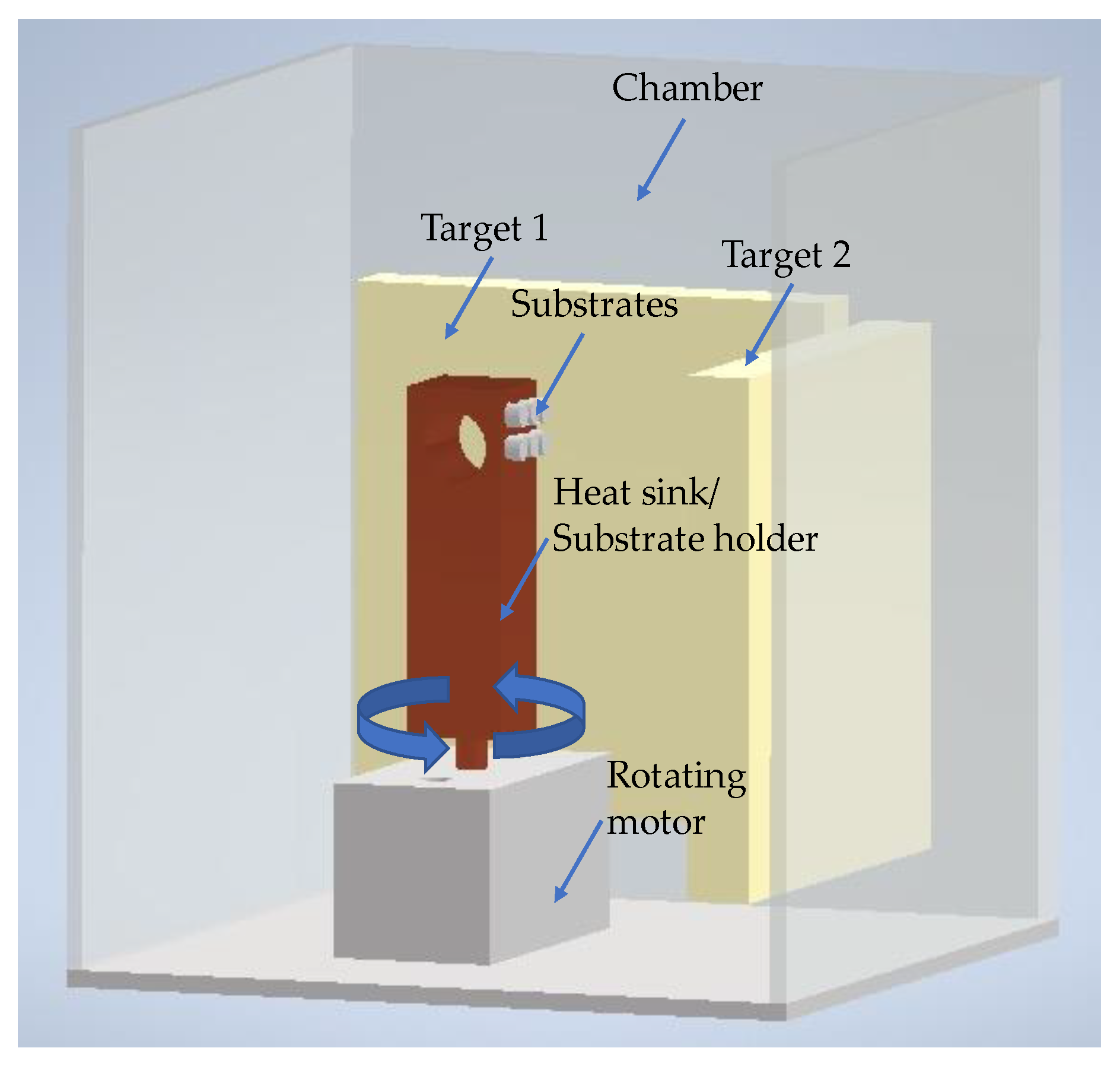
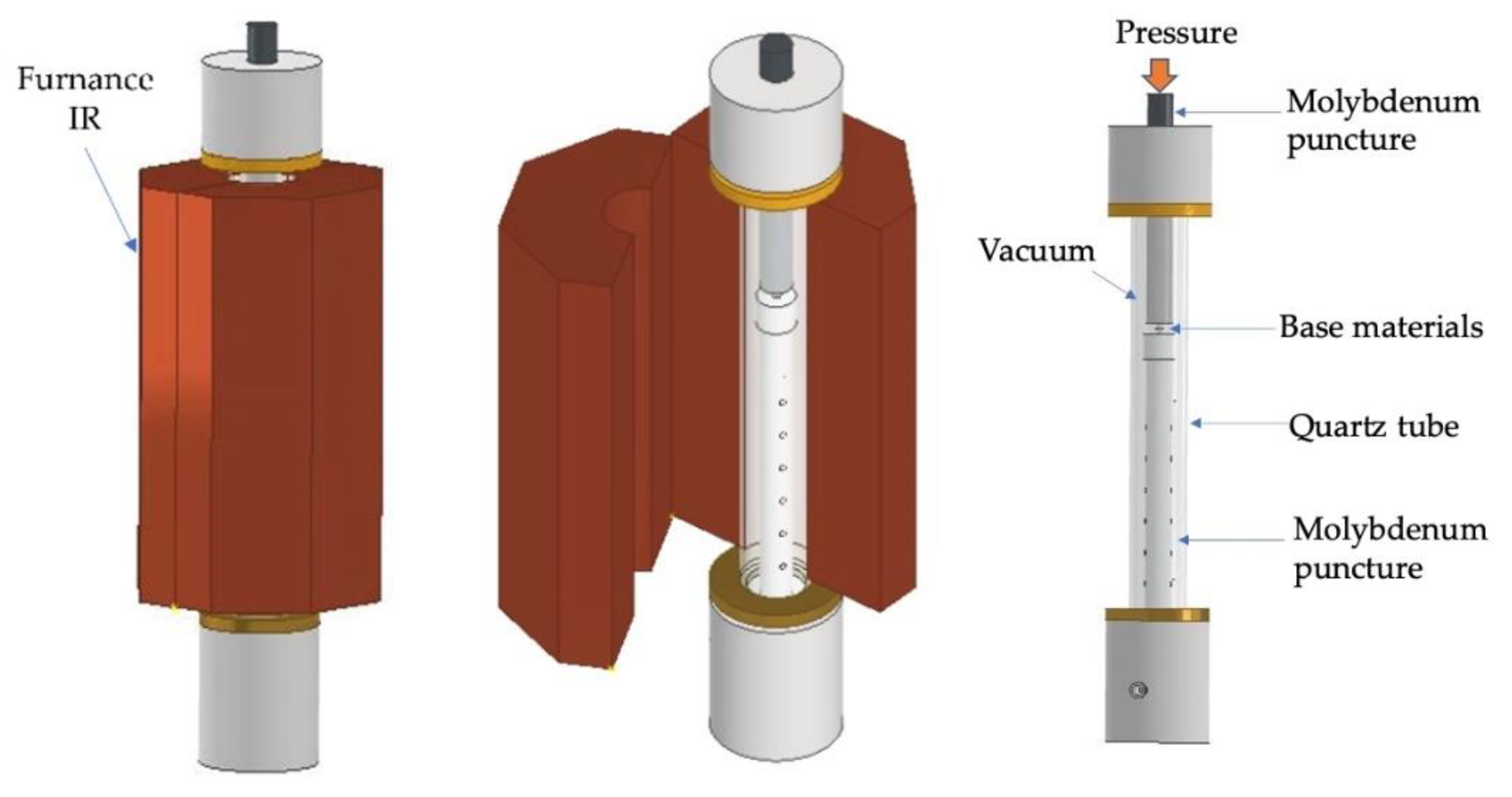
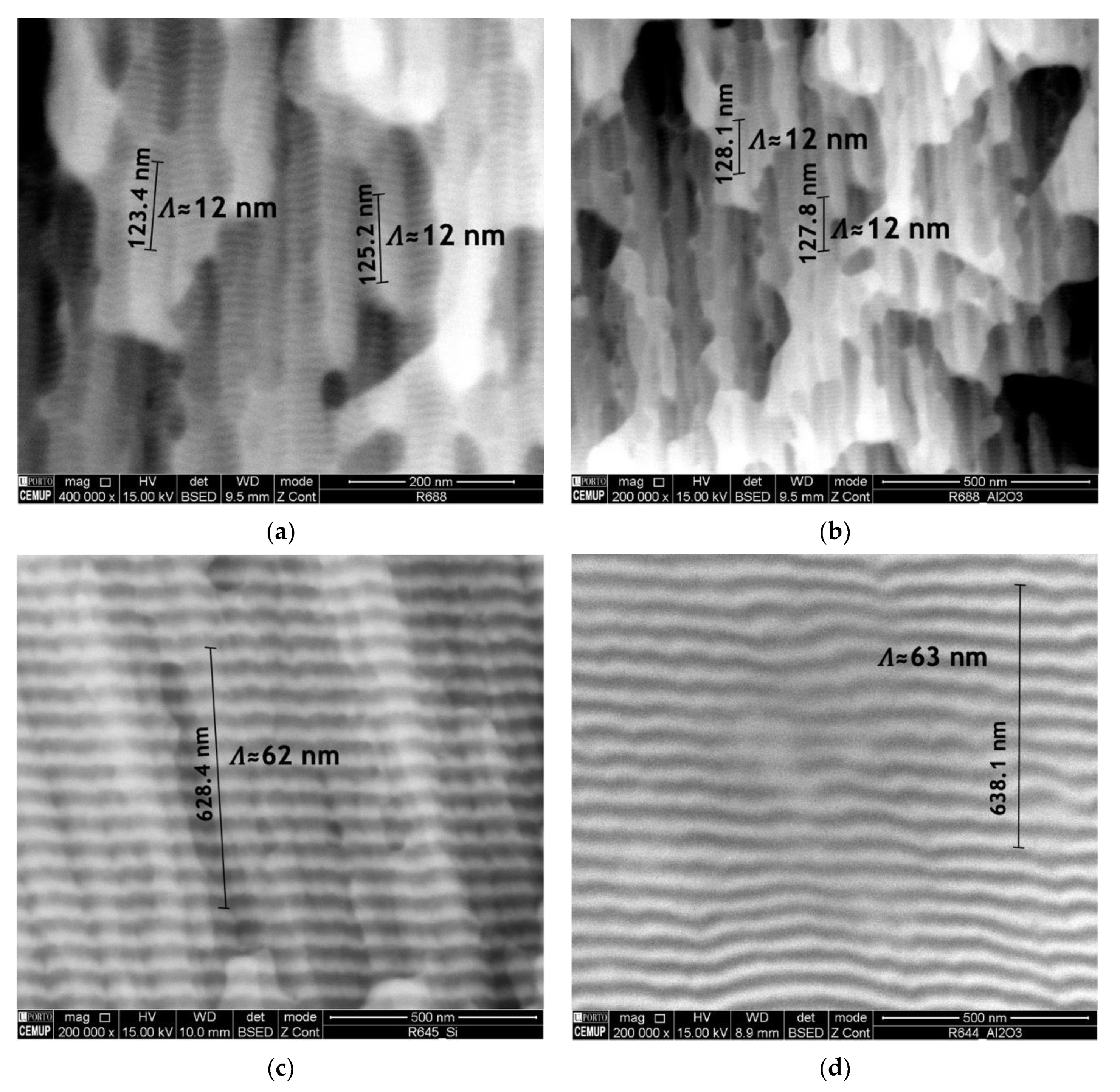

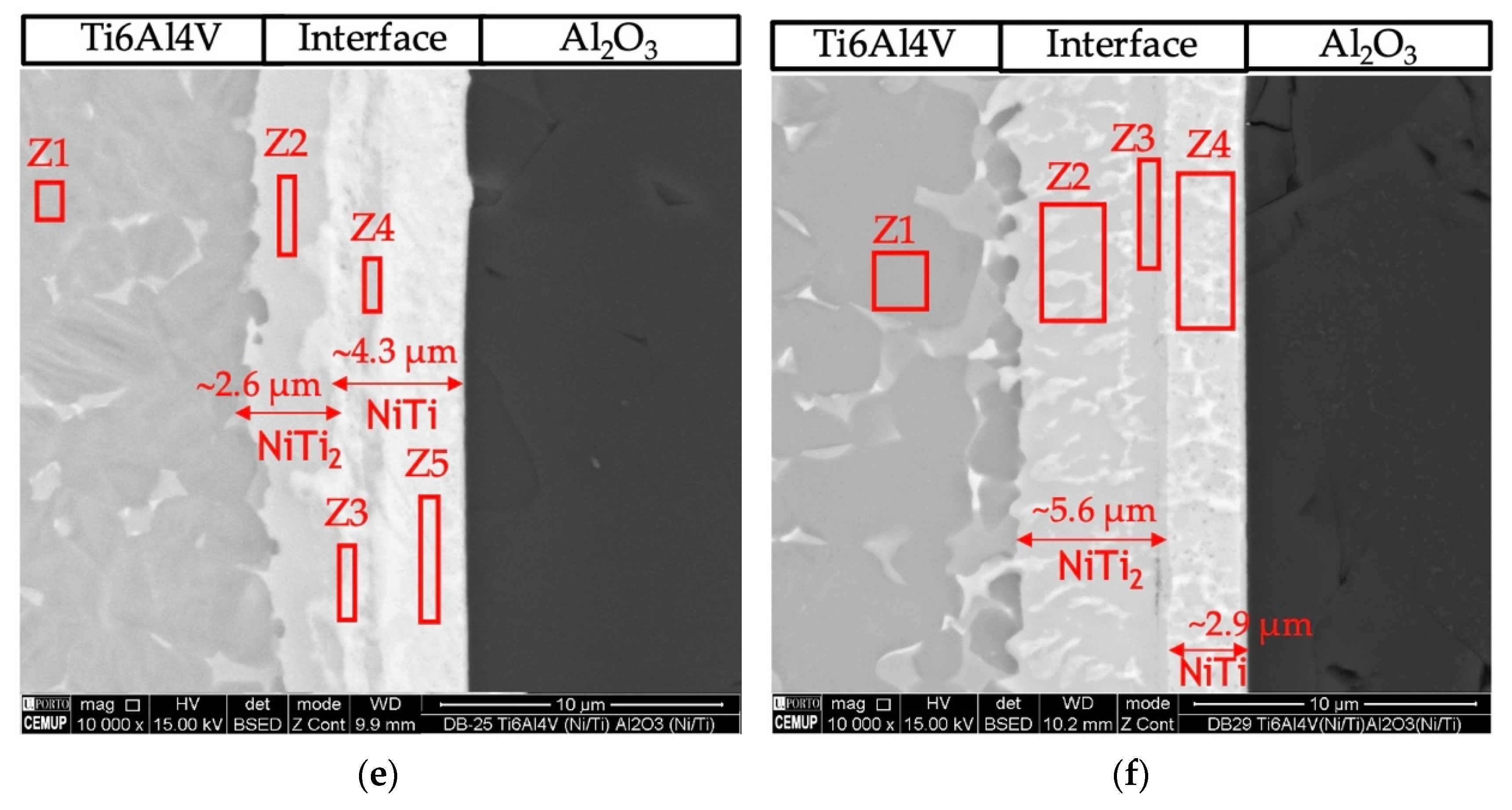

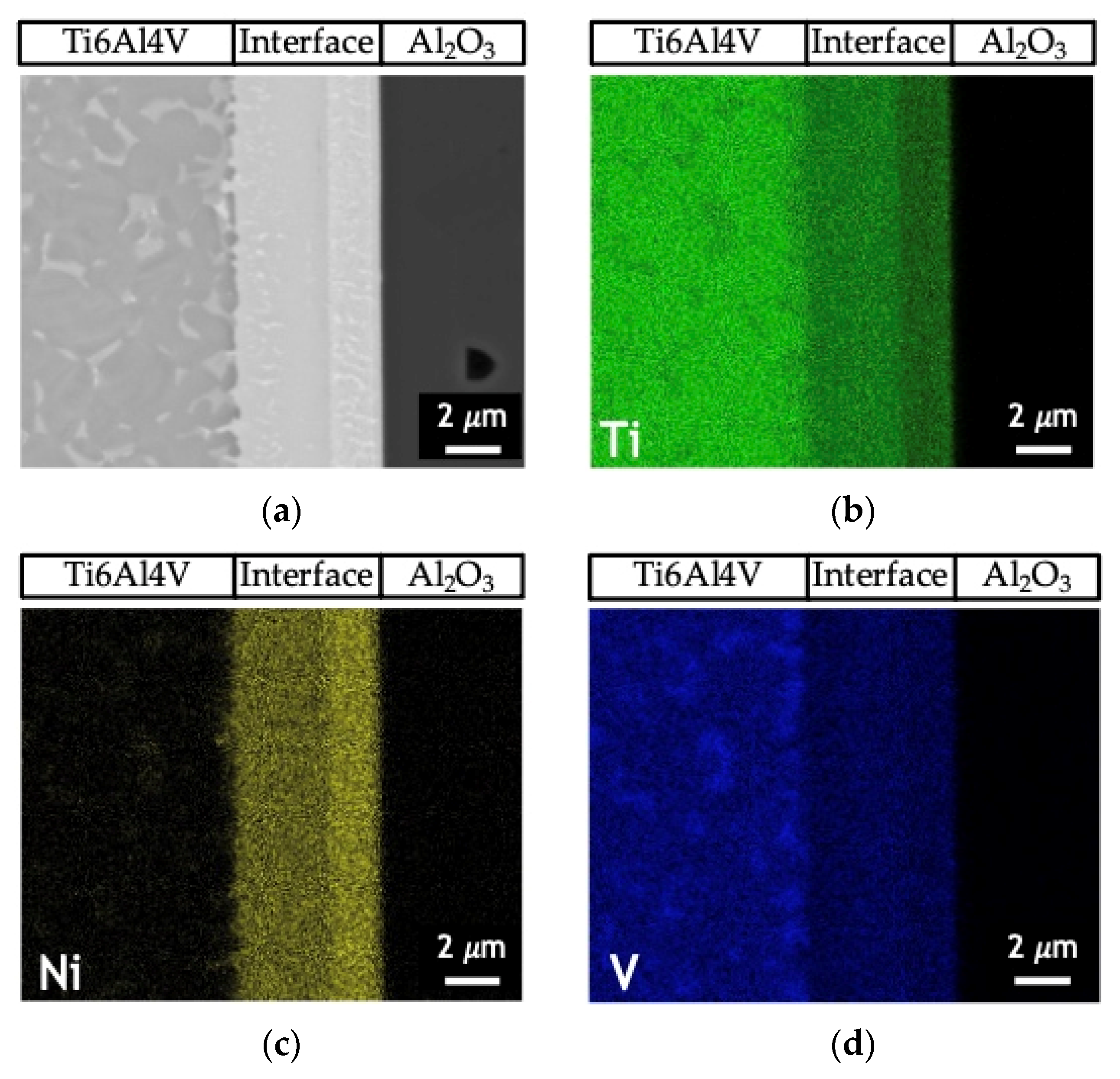
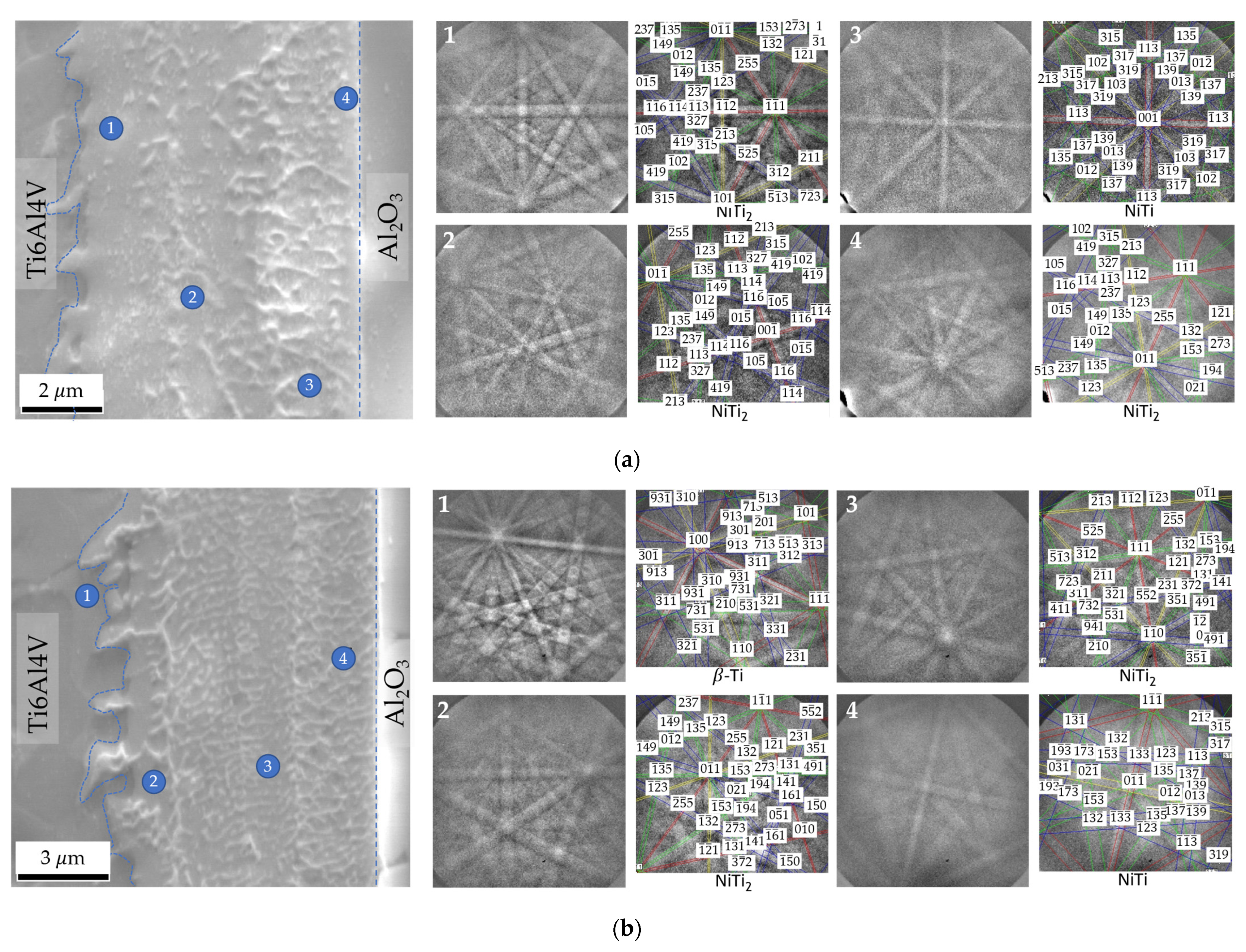

| Temperature/ Modulation Period Λ | Zone | Element (at.%) | Possible Phases | |||
|---|---|---|---|---|---|---|
| Ti | Al | V | Ni | |||
| 800 °C/12 nm (Figure 4b) | 1 | 88.6 | 9.7 | 1.7 | - | α-Ti |
| 2 | 65.0 | 3.5 | 2.3 | 29.2 | NiTi2 | |
| 3 | 60.8 | 1.5 | 2.6 | 35.1 | NiTi2 | |
| 4 | 61.0 | 1.0 | 3.0 | 35.0 | NiTi2 | |
| 5 | 50.3 | 1.4 | 3.3 | 45.0 | NiTi | |
| 750 °C/25 nm (Figure 4c) | 1 | 88.4 | 9.9 | 1.7 | - | α-Ti |
| 2 | 74.9 | 4.6 | 14.0 | 6.5 | β-Ti + NiTi2 | |
| 3 | 76.4 | 6.2 | 7.4 | 10.0 | β-Ti + NiTi2 | |
| 4 | 64.0 | 3.8 | 2.2 | 30.0 | NiTi2 | |
| 5 | 63.0 | 1.0 | 2.9 | 33.1 | NiTi2 | |
| 6 | 50.5 | 0.5 | 3.6 | 45.4 | NiTi | |
| 7 | 48.5 | 19.6 | 2.6 | 29.3 | α2-Ti3Al +AlNi2Ti + NiTi2 | |
| 800 °C/25 nm (Figure 4d) | 1 | 86.0 | 11.0 | 3.0 | - | α-Ti |
| 2 | 65.0 | 4.4 | 1.8 | 28.8 | NiTi2 | |
| 3 | 63.3 | 2.8 | 2.4 | 31.5 | NiTi2 | |
| 4 | 65.0 | 1.8 | 3.0 | 30.2 | NiTi2 | |
| 5 | 54.0 | 1.0 | 4.0 | 41.0 | NiTi2+ NiTi | |
| 6 | 50.7 | 1.5 | 3.8 | 44.0 | NiTi | |
| 7 | 68.0 | 3.0 | 29.0 | NiTi2 | ||
| 750 °C/60 nm (Figure 4e) | 1 | 88.1 | 10.1 | 1.8 | - | α-Ti |
| 2 | 63.7 | 2.9 | 1.7 | 31.7 | NiTi2 | |
| 3 | 50.5 | 0.6 | 3.4 | 45.5 | NiTi | |
| 4 | 53.0 | 0.6 | 3.8 | 43.6 | NiTi+ NiTi2 | |
| 5 | 45.4 | 0.7 | 3.3 | 50.6 | NiTi | |
| 800 °C/60 nm (Figure 4f) | 1 | 87.0 | 11.0 | 2.0 | - | α-Ti |
| 2 | 63.0 | 3.0 | 2.0 | 32.0 | NiTi2 | |
| 3 | 60.0 | 0.9 | 3.0 | 36.1 | NiTi2 | |
| 4 | 48.0 | 3.3 | 3.5 | 45.2 | NiTi | |
Publisher’s Note: MDPI stays neutral with regard to jurisdictional claims in published maps and institutional affiliations. |
© 2022 by the authors. Licensee MDPI, Basel, Switzerland. This article is an open access article distributed under the terms and conditions of the Creative Commons Attribution (CC BY) license (https://creativecommons.org/licenses/by/4.0/).
Share and Cite
Silva, M., Jr.; Ramos, A.S.; Vieira, M.T.; Simões, S. Joining of Ti6Al4V to Al2O3 Using Nanomultilayers. Nanomaterials 2022, 12, 706. https://doi.org/10.3390/nano12040706
Silva M Jr., Ramos AS, Vieira MT, Simões S. Joining of Ti6Al4V to Al2O3 Using Nanomultilayers. Nanomaterials. 2022; 12(4):706. https://doi.org/10.3390/nano12040706
Chicago/Turabian StyleSilva, Marcionilo, Jr., Ana Sofia Ramos, Maria Teresa Vieira, and Sónia Simões. 2022. "Joining of Ti6Al4V to Al2O3 Using Nanomultilayers" Nanomaterials 12, no. 4: 706. https://doi.org/10.3390/nano12040706
APA StyleSilva, M., Jr., Ramos, A. S., Vieira, M. T., & Simões, S. (2022). Joining of Ti6Al4V to Al2O3 Using Nanomultilayers. Nanomaterials, 12(4), 706. https://doi.org/10.3390/nano12040706








